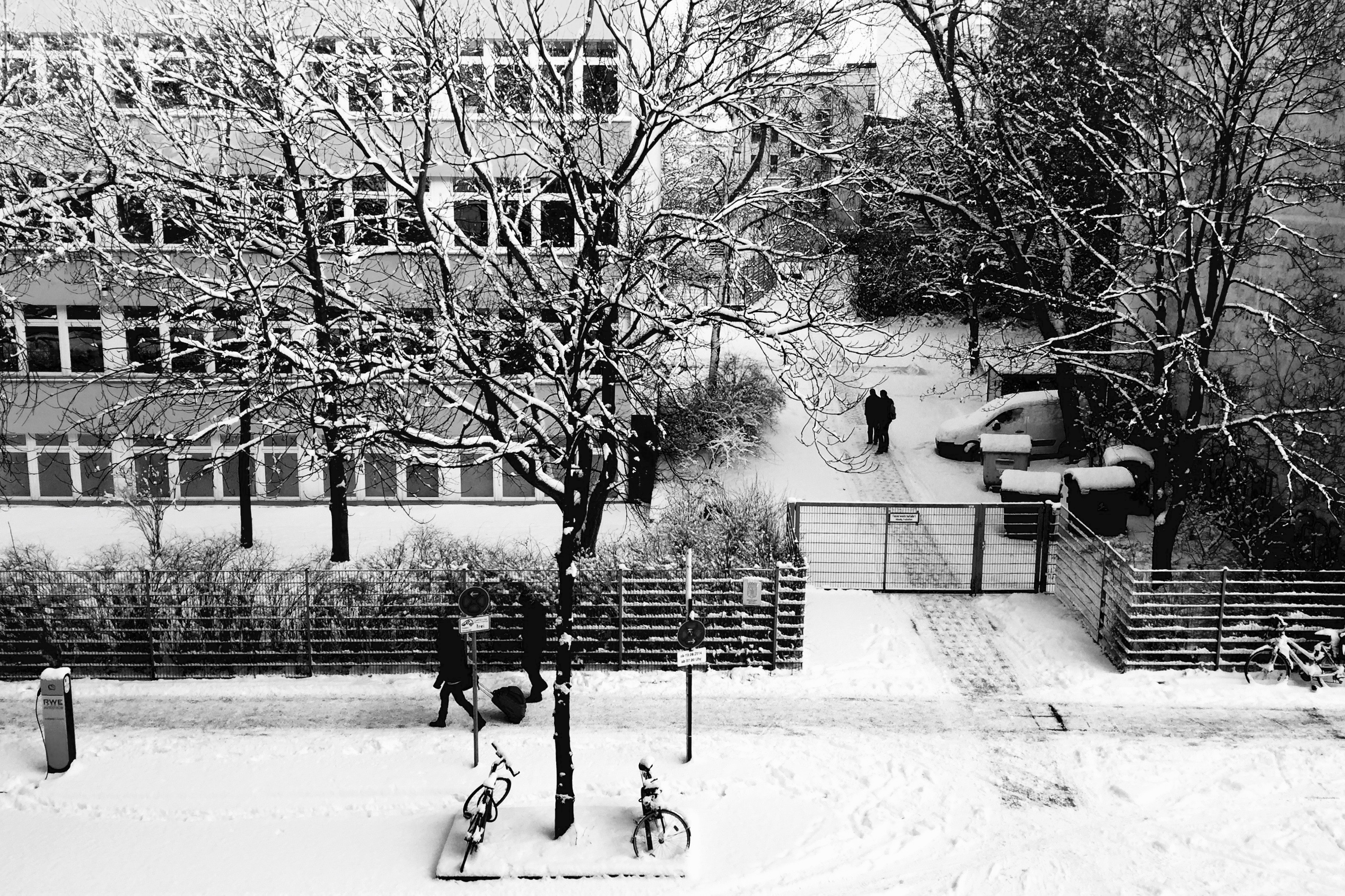I had no intention of bicycling in the snow, this winter. I started riding just seven months ago to stave off the inevitable corrosion of old age. I have no tolerance of cold. I grew up on the beaches of Sydney, where anything below 15ºC is thought of as gelid. In Berlin, the average winter temperature is around -1ºC and it can get much colder, especially in the late afternoon or if anything more than a light breeze blows. As I write this, in the middle of January, it’s -7ºC.
Berliners don’t make many concessions to their bad weather. They certainly don’t read the annual articles in cycle magazines about what you must wear when the temperature drops below freezing. For most, cycling is a quotidian necessity that has little to do with sport. They dress as they would if they were walking to a corner store or a café: a knitted beanie, a scarf, a warm coat, thick-soled boots, and woollen gloves. No ‘technical’ outerwear, no lycra. And no helmet.
Most of my own winter wear – including an olive drab Russian ushanka with rabbit-fur ear muffs – was bought at a local military disposal store. The English novelist, Ian Parkinson, gave me a pair of Arctic-ready, double insulated, Skytec Argon rubber-coated gloves he found at a builder’s merchant and I bought an oversize merino wool scarf that I wrap around my head and face like a keffiyeh when it’s especially cold. My wardrobe has come a long way since I first arrived in Berlin from south-west France, four years ago. Back then, I didn’t own a pair of socks, let alone a coat.
I was just three kilometres from home but it was far enough to feel like an expedition. Snow flurries obscured my vision, and settled on my clothes like an aggressive fungus.
Berlin bikes are also about practicality over style. You might come across a smattering of ascetic fixies or vintage Italian road racers, but the majority are proletarian work-horses – well-used, even a little clapped out, laden with racks, baskets and baby-seats. My own bike is a classic, Dutch-built omafiets, with the lugged-steel, V-shaped or ‘step-through’ frame originally devised by the English in the late Victorian period. English cyclists still refer to it, dismissively, as a ‘lady’s bike’ – omafiets is Dutch for ‘grandmother’s bike’ – but in northern Europe it’s regarded as unisex. The high, upright riding position is ideal for commuting across the flat topography of cities like Amsterdam, Copenhagen and Berlin.
The omafiets has evolved over the past century to meet the rigours of all-weather urban cycling. It might not be light – mine weighs more than 22 kilos – but everything about its mechanics and fittings reduces maintenance and increases utility, if not performance. A rear ‘coaster’ brake and gears – rarely more than three – are sealed in a weather-proof stainless steel or alloy hub on the back wheel. A separate sealed hub on the front wheel contains the front break and a dynamo for powering the lights (and a GPS or mobile phone, if you like). The simplified chain set is fully enclosed to prevent ice and grit from clogging the chainring and chain links, and to keep grease away from a rider’s clothing, and there are generous mudguards over both wheels. The top of the back wheel is partially skirted with plastic to prevent long dresses or coats from becoming entangled in the spokes. On my bike, hefty cargo racks, front and back, can carry a total of around 50 kilos: technically, my omafiets is a transportfiets.
Berlin’s road surfaces are rarely so icy that you need the metal-studded rubber tires that are commonplace in more northern latitudes. The bike shop I frequent laughed when I asked about them, although they did switch out my shallow Continental treads for agricultural-looking Schwalbe Marathons. And it was while I was helping the shop mechanic pry the old tires off their rims that the first of this winter’s snow started falling. Within an hour, the sidewalks were covered.
I was just three kilometres from home but it was far enough to feel like an expedition. It wasn’t just the powdery slipperiness of the roads. Snow flurries obscured my vision, and settled on my clothes like an aggressive fungus. Leaving the bike shop, I pedalled a short distance along the sidewalk. Alert to uncertain traction, I clenched the handlebars, anticipating slippage. The sound of the tires in the fresh snow was like faint white noise from a radio tuned between stations. I clicked up a gear and pushed down harder on the pedals to see-saw off the curb onto Torstrasse, just as the flow of afternoon traffic was stemmed by a red light. I sliced across two lanes to the safety of a pedestrian island, and from there to a cobbled side street heading towards Nordbahnhof.
I reached home no more than ten minutes later. But by then I had become a real Berlin radfahrer, a die-hard, inured to winter.
‘A New Map of Berlin’ is a series of dispatches by C.C O’Hanlon, in words and photographs, from his exploration of the city on a bike.
Image credit: A winter in Berlin (Gartenstrasse, in Mitte), 2014. Photo by C.C. O’Hanlon.

